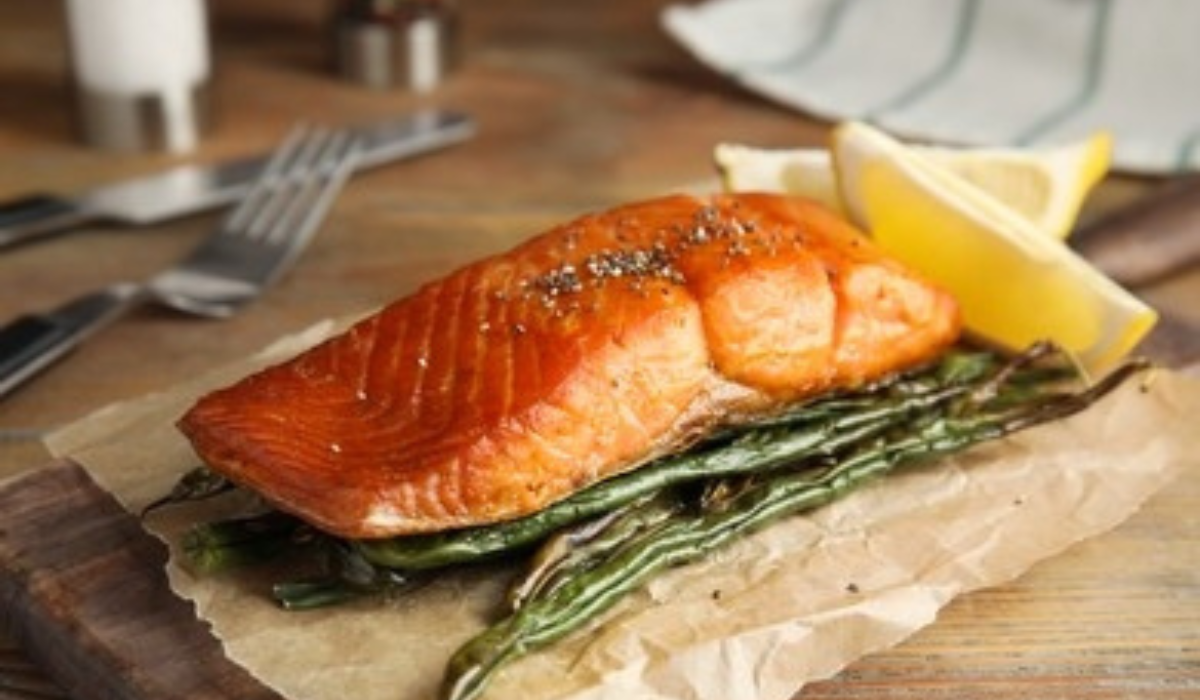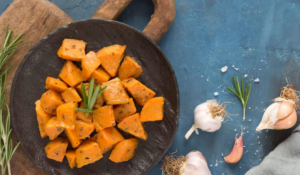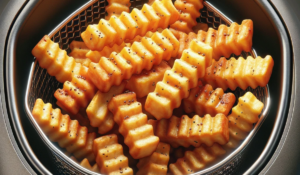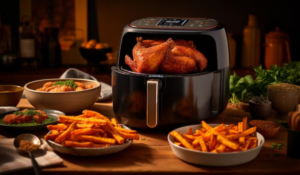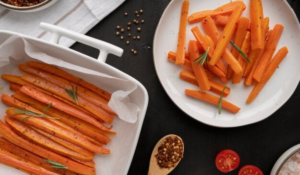Sharing is caring!
Table of Contents
ToggleIntroduction to Frozen Salmon Cooking
Cooking frozen salmon in an air fryer has revolutionized how we approach seafood in the kitchen. This method combines convenience with health benefits, making it a favorite among busy home cooks and health enthusiasts alike. When you use an air fryer, you unlock a world where frozen salmon transforms into a culinary delight with minimal effort.
The journey begins with understanding the basics of frozen salmon. Not all frozen salmon is created equal, and choosing the right type is crucial for optimal flavor and texture. We delve into the different varieties available and offer tips on selecting high-quality frozen salmon that promises a delicious outcome.
Preparing frozen salmon for the air fryer is a straightforward process. Whether you’re a seasoned cook or a beginner, you’ll find that a few simple steps can lead to mouth-watering results. From thawing techniques to seasoning ideas, we cover everything you need to know to get your frozen salmon air fryer-ready.
The air fryer itself is a game-changer in cooking frozen salmon. Its rapid air technology cooks the salmon evenly and locks in moisture, ensuring a meal that’s both crispy and tender. Plus, it’s a healthier alternative to traditional frying methods, reducing the need for excessive oil without compromising on taste.
In this guide, we provide a step-by-step approach to cooking frozen salmon in an air fryer. We’ll discuss everything from preheating the air fryer to setting the right temperature and timing, ensuring your frozen salmon turns out perfectly every time. Whether you’re preparing a quick weeknight dinner or a special meal, cooking frozen salmon in an air fryer is an efficient, healthy, and delicious choice. Let’s dive into the world of frozen salmon and discover how your air fryer can transform this humble ingredient into a gourmet dish.
Choosing the Right Frozen Salmon for Air Frying
When it comes to air frying, selecting the right frozen salmon is crucial for achieving the best results. The key lies in understanding the various types of frozen salmon available and knowing what to look for. This knowledge ensures your frozen salmon in air fryer experience is both delicious and satisfying.
Firstly, familiarize yourself with the types of salmon out there. You’ll find options ranging from sockeye to king salmon, each offering a unique flavor and texture profile. Sockeye salmon, known for its rich color and robust taste, is a popular choice for its firm texture that holds up well in an air fryer. King salmon, prized for its high-fat content, delivers a tender and juicy result.
When shopping for frozen salmon, pay close attention to the packaging. Look for salmon that is vacuum-sealed and free of ice crystals. This indicates that the salmon has been frozen quickly and properly, retaining its quality and flavor. Also, check the label for any additives or preservatives; the best frozen salmon is often just pure fish, without unnecessary extras.
Thickness plays a crucial role too. Opt for uniformly thick pieces that will cook evenly in your air fryer. Uneven thickness can lead to parts of the salmon being over or undercooked. If possible, select fillets or portions instead of a whole side of salmon, as they are more manageable and cook more evenly in an air fryer.
Lastly, consider sustainability. Choose frozen salmon that is sustainably sourced to ensure you’re not only enjoying a tasty meal but also contributing positively to the environment.
By keeping these factors in mind, you can confidently choose the best frozen salmon for your air fryer. The right selection will pave the way for a delicious, healthful, and enjoyable cooking experience with your frozen salmon in air fryer.
Preparation Tips for Frozen Salmon
Preparing frozen salmon for cooking, especially when using an air fryer, involves a few essential steps to ensure the best flavor and texture. Whether you’re a seasoned chef or a kitchen novice, these tips will help you master the art of cooking frozen salmon in an air fryer.
Firstly, consider thawing your frozen salmon, although it’s not mandatory for air frying. If you choose to thaw, do it safely by placing the salmon in the refrigerator overnight. This slow process prevents bacterial growth and maintains the fish’s quality. For a quicker method, immerse the sealed salmon in cold water for about an hour. Avoid using hot water or microwaving for thawing, as these methods can partially cook the fish and affect its texture.
Once thawed or if you’re cooking straight from frozen, pat the salmon dry with paper towels. Removing excess moisture is key for a crispier finish in the air fryer. Then, move on to seasoning your salmon. Here, simplicity often works best. A sprinkle of salt and pepper can enhance the natural flavors of the salmon. For more adventurous palates, experiment with garlic powder, lemon zest, or dill for added zest.
If you’re using a marinade, limit the marinating time to 30 minutes to an hour. Salmon is delicate and can become mushy if marinated for too long. Light oil brushing can also help prevent sticking and aid in crisping the exterior.
When placing the salmon in the air fryer, ensure you don’t overcrowd the basket. This ensures even cooking and proper air circulation. Preheating the air fryer for a few minutes before adding the salmon can also contribute to a more even cook.
The Air Fryer Advantage
Using an air fryer to cook frozen salmon offers numerous benefits, making it a preferred method for both novice and experienced cooks. The air fryer’s unique cooking mechanism brings out the best in frozen salmon, providing a perfect blend of convenience, health, and taste.
One of the most significant advantages of an air fryer is its ability to cook frozen salmon evenly and quickly. Unlike traditional methods, where you might worry about uneven cooking or dryness, the air fryer circulates hot air around the salmon, ensuring a consistent cook. This results in a crispy exterior while retaining the moisture and tenderness inside, a feat often challenging to achieve with other cooking methods.
Health-wise, air frying frozen salmon is a win. This method requires significantly less oil than pan-frying or deep-frying, reducing the overall fat content of your meal. You get to enjoy the rich flavors and health benefits of salmon, like its omega-3 fatty acids, without the extra calories and fats from oil. It’s an ideal way to prepare a nutritious meal that doesn’t compromise on taste.
The convenience of using an air fryer for frozen salmon cannot be overstated. There’s no need for thawing, making it a time-saver for busy individuals. You can take the salmon straight from the freezer, season it, and place it in the air fryer. Within minutes, you have a perfectly cooked, restaurant-quality meal, saving you both time and effort.
Moreover, air fryers are user-friendly and easy to clean, adding to their appeal. They are a great addition to any kitchen, offering a hassle-free way to cook a variety of dishes, including frozen salmon.
Step-by-Step Guide to Cooking Frozen Salmon in an Air Fryer
Cooking frozen salmon in an air fryer is a straightforward process that yields delicious results. Here’s a simple guide to help you master this cooking method:
- Preheat Your Air Fryer: Start by preheating your air fryer to 400°F (200°C). This step is crucial for ensuring even cooking and achieving a crispy texture.
- Prepare the Salmon: If your frozen salmon is not pre-seasoned, pat it dry and season it to your liking. You can use simple seasonings like salt, pepper, and lemon juice, or get creative with herbs and spices.
- Arrange the Salmon in the Air Fryer: Place the frozen salmon fillets in the air fryer basket. Make sure to leave some space between each fillet to allow for proper air circulation. This ensures even cooking and crispiness.
- Cooking Time: Cook the frozen salmon for about 12-15 minutes. The exact time might vary depending on the thickness of the fillets and your air fryer model. Halfway through the cooking time, you can gently flip the salmon to ensure it cooks evenly on both sides.
- Check for Doneness: The salmon is done when it reaches an internal temperature of 145°F (63°C) and flakes easily with a fork. If needed, you can add a few more minutes to the cooking time to reach the desired doneness.
- Rest and Serve: Once cooked, let the salmon rest for a couple of minutes in the air fryer. This allows the juices to redistribute, making the salmon moist and flavorful. Serve your perfectly cooked frozen salmon with your choice of sides and enjoy!
This step-by-step guide to cooking frozen salmon in an air fryer demonstrates how easy and convenient it is to prepare a healthy and delicious meal. With minimal preparation and cooking time, you can enjoy a gourmet-like dish right in the comfort of your home.
Creative Recipes Using Frozen Salmon and Air Fryer
Lemon Herb Crusted Frozen Salmon
-
- Ingredients: Frozen salmon fillets, lemon zest, mixed dried herbs (thyme, rosemary, oregano), garlic powder, olive oil, salt, and pepper.
- Preparation: Mix lemon zest, herbs, garlic powder, salt, and pepper with olive oil to form a paste. Brush this mixture over the salmon fillets.
- Air Frying: Preheat the air fryer to 400°F. Place the seasoned salmon in the basket and cook for 12-15 minutes, until the crust is golden and salmon is flaky.
Honey Glazed Salmon with Sesame Seeds
-
- Ingredients: Frozen salmon fillets, honey, soy sauce, minced garlic, sesame seeds, and a dash of sriracha for heat.
- Preparation: Combine honey, soy sauce, garlic, and sriracha. Glaze the salmon with this mixture and sprinkle sesame seeds on top.
- Air Frying: Cook at 380°F for about 10-12 minutes. The glaze should caramelize, and the salmon should be cooked through.
Cajun Spiced Salmon
-
- Ingredients: Frozen salmon fillets, Cajun seasoning, paprika, a touch of brown sugar, and olive oil.
- Preparation: Mix Cajun seasoning, paprika, and brown sugar. Rub this mix onto the salmon fillets with a bit of olive oil.
- Air Frying: Air fry at 400°F for 12-15 minutes. The outside should be slightly crisp, and the inside tender and juicy.
Asian-Inspired Teriyaki Salmon
-
- Ingredients: Frozen salmon fillets, teriyaki sauce, minced ginger, minced garlic, and green onions for garnish.
- Preparation: Marinate the salmon in teriyaki sauce mixed with ginger and garlic for about 30 minutes.
- Air Frying: Cook the marinated salmon at 380°F for 10-14 minutes. Garnish with green onions before serving.
Mediterranean Style Salmon with Olives and Tomatoes
-
- Ingredients: Frozen salmon fillets, cherry tomatoes, sliced olives, feta cheese, oregano, and olive oil.
- Preparation: Top the salmon with halved cherry tomatoes, olives, crumbled feta, oregano, and a drizzle of olive oil.
- Air Frying: Air fry at 380°F for 12-15 minutes. The tomatoes should be bursting, and the feta slightly browned.
Each of these recipes highlights the versatility of cooking frozen salmon in an air fryer, offering a range of flavors from around the world. These dishes are not only delicious but also incredibly easy to prepare, making them perfect for any day of the week.
Pairing Sides with Your Air Fried Salmon
When serving frozen salmon cooked in an air fryer, choosing the right side dishes can elevate your meal to the next level. The key is to select sides that complement the rich, flavorful taste of the salmon without overpowering it. Here are some delightful pairings to consider:
- Garlic Roasted Asparagus: Asparagus, with its fresh and slightly grassy flavor, is a classic pairing for salmon. Toss asparagus spears in olive oil, minced garlic, salt, and pepper, and roast them in the air fryer for about 10 minutes at 400°F. This quick and easy side dish adds a nutritious and flavorful touch to your frozen salmon meal.
- Lemon Butter Baby Potatoes: Baby potatoes, when tossed in a mix of melted butter, lemon zest, and herbs, and then air fried until golden, make a comforting side. Their creamy texture and zesty flavor perfectly balance the richness of the salmon.
- Quinoa Salad with Fresh Herbs: For a lighter, health-conscious side, mix cooked quinoa with chopped fresh herbs like parsley, dill, or basil. Add a squeeze of lemon juice and a drizzle of olive oil for a refreshing and nutritious accompaniment to your salmon.
- Crispy Air Fryer Brussels Sprouts: Brussels sprouts become irresistibly crispy and delicious when cooked in an air fryer. Toss them with a bit of oil, salt, and pepper, and cook until crispy. Their earthy flavor pairs wonderfully with the savory notes of salmon.
- Cucumber Dill Salad: A simple salad of sliced cucumbers, dill, and a light yogurt dressing can offer a cool, tangy contrast to the warm, flaky salmon.
- Steamed Jasmine Rice: For those who prefer traditional pairings, steamed jasmine rice is a foolproof choice. Its subtle fragrance and soft texture provide a comforting base for the flavorful salmon.
Sauces and Toppings for Enhanced Flavor
Enhancing your frozen salmon in an air fryer with the right sauces and toppings can turn a simple dish into a gourmet experience. Here are some ideas to add an extra burst of flavor to your salmon:
- Classic Dill Sauce: Mix sour cream or Greek yogurt with chopped dill, lemon juice, and a pinch of garlic powder. This creamy sauce adds a fresh and tangy flavor that pairs beautifully with the richness of the salmon.
- Spicy Sriracha Mayo: Combine mayonnaise with Sriracha, a squeeze of lime, and a hint of honey. This spicy, creamy sauce adds a kick that perfectly complements the mild flavor of salmon.
- Sweet and Tangy Glaze: Whisk together soy sauce, honey, and a bit of ginger. Brush this glaze on the salmon during the last few minutes of air frying for a sweet and savory finish.
- Lemon Caper Butter: Melt butter and stir in capers, lemon zest, and a little parsley. Drizzle this zesty butter over the cooked salmon for an elegant and flavorful topping.
- Pesto Spread: Spread a thin layer of basil pesto on the salmon before air frying. The pesto infuses the fish with herby and nutty flavors, enhancing its natural taste.
- Mango Salsa: Dice mango, red onion, jalapeño, and cilantro. Toss with lime juice and a pinch of salt. This fruity salsa adds a refreshing and slightly spicy touch to the dish.
- Balsamic Reduction: Simmer balsamic vinegar until it thickens. Drizzle this reduction over the salmon for a gourmet touch with a sweet and tangy flavor.
Each of these sauces and toppings brings a unique dimension to your frozen salmon in an air fryer. Experiment with these combinations to discover your favorite way to enhance the natural flavors of salmon and elevate your meal.
Troubleshooting Common Issues with Frozen Salmon in Air Fryer
Cooking frozen salmon in an air fryer can sometimes present challenges. Here are some common issues you might encounter and how to resolve them:
- Salmon is Cooking Unevenly: If your salmon fillets are not cooking evenly, check their placement in the air fryer. Ensure there’s enough space around each piece for proper air circulation. Also, consider the thickness of the fillets – thinner parts cook faster than thicker ones. To address this, you can slightly fold under the thinner edges.
- Exterior is Too Dry or Overcooked: If the outside of your salmon gets too dry, you might be cooking it at too high a temperature or for too long. Try reducing the cooking time or temperature. A light brush of oil on the salmon before cooking can also help keep it moist.
- Salmon Sticking to the Basket: Prevent sticking by ensuring the air fryer basket is clean and non-stick. A light spray of cooking oil on the basket before adding the salmon can also help. If you’re using a marinade or glaze, make sure it’s not too sugary, as high sugar content can cause sticking.
- Undercooked Salmon: If your salmon is undercooked, it might be due to its thickness or starting temperature. Increase the cooking time in small increments, checking for doneness each time. Remember, salmon should reach an internal temperature of 145°F.
- Lack of Flavor: To enhance the flavor, season your salmon adequately before cooking. Marinating it for 30 minutes to an hour can also infuse more taste. Experiment with different herbs, spices, or sauces to find your preferred flavor profile.
By addressing these common issues, you can enjoy perfectly cooked, flavorful frozen salmon in your air fryer every time. Adjustments in cooking times, temperatures, and seasoning can make a significant difference in achieving your desired outcome.
Advanced Techniques and Variations for Cooking Frozen Salmon in Air Fryer
Mastering the art of cooking frozen salmon in an air fryer opens the door to a range of advanced techniques and creative variations. Here are some ideas to elevate your dishes:
- Marinating for Depth of Flavor: For an intense flavor boost, marinate your salmon for up to an hour before air frying. Experiment with combinations like soy sauce and ginger, or balsamic and garlic. Just remember to pat the salmon dry before cooking to achieve a crispy exterior.
- Infusing with Smoke: To add a smoky flavor, consider using a dash of smoked paprika or a small amount of liquid smoke in your marinade or seasoning. This will give the salmon a BBQ-like taste without the grill.
- Creating a Crispy Coating: For a crunchy texture, lightly coat your salmon with a mixture of panko breadcrumbs and parmesan cheese. Spray a bit of oil over the coated salmon to help achieve a golden crust.
- Experimenting with Cooking Times and Temperatures: Play around with lower temperatures and longer cooking times for a more gently cooked salmon. This is great for thicker fillets or when you want a more tender, less crispy texture.
- Glazing Towards the End: Apply a glaze, like honey mustard or maple syrup-based sauce, during the last few minutes of cooking. This prevents the glaze from burning while imparting a rich, caramelized flavor.
- Adding Aromatic Herbs: Place fresh herbs like dill, rosemary, or thyme directly in the air fryer basket with the salmon. The heat will release the herbs’ oils, subtly infusing the fish.
- Wrapping in Foil for Moisture Retention: For an even more tender result, try cooking your salmon wrapped in foil. This technique steams the fish inside the air fryer, keeping it moist and infusing the flavors of any added seasonings.
Accessorizing Your Air Fryer for Optimal Cooking of Frozen Salmon
To get the most out of your frozen salmon in an air fryer, accessorizing your air fryer can be a game changer. These accessories not only enhance the cooking experience but also expand the range of recipes you can try:
- Silicone or Parchment Liners: These liners prevent sticking and make cleanup a breeze. They’re particularly useful when cooking marinated or glazed salmon, as they catch any drips and prevent burning on the basket.
- Oil Sprayer: An oil sprayer allows you to apply a fine mist of oil evenly on the frozen salmon. This ensures a crispy exterior without using excessive oil, keeping your meal healthy and delicious.
- Air Fryer Rack or Skewers: If your air fryer model allows, use a rack or skewers to elevate the salmon. This promotes even air circulation around the fish, ensuring uniform cooking and crispiness.
- Digital Meat Thermometer: A reliable thermometer takes the guesswork out of cooking, ensuring your salmon reaches the perfect internal temperature of 145°F for optimal doneness.
- Non-Metallic Tongs: To avoid scratching the non-stick surface of your air fryer basket, use non-metallic tongs for flipping or removing the salmon. Silicone-tipped tongs are a great option.
- Basting Brush: A basting brush is ideal for applying marinades or glazes to your salmon. It allows for an even coating, which enhances flavor and prevents dryness.
- Foil or Silicone Cups: For individual salmon portions or when experimenting with salmon patties, these cups can be a convenient option. They help retain shape and make serving easier.
By equipping your kitchen with these accessories, you can optimize your air fryer for cooking frozen salmon, ensuring each meal is not only easy to prepare but also consistently delicious. These tools open up new possibilities for creativity and precision in your cooking, making every frozen salmon dish a success.
Expert Advice: Chefs’ Secrets for Perfect Air Fried Salmon
Achieving perfection with frozen salmon in an air fryer is an art. Here are some expert tips from chefs that can elevate your air-fried salmon to restaurant-quality:
- Preheat for Perfection: Always preheat your air fryer before cooking. This ensures a quick and even cook, giving the salmon a perfectly crispy exterior.
- Season Just Right: Don’t be shy with seasoning. A blend of salt, pepper, and your favorite herbs can enhance the natural flavors of salmon. For a twist, add a sprinkle of brown sugar to create a caramelized crust.
- Avoid Overcrowding: Cook in batches if necessary. Ensuring each piece of salmon has enough space around it is key for even cooking and crispiness.
- Pat Dry Before Cooking: Moisture is the enemy of crispiness. Pat the salmon dry thoroughly before seasoning and cooking to get that desirable crispy texture.
- Mind the Thickness: Adjust cooking times based on the thickness of the fillets. Thicker pieces might need a few extra minutes, while thinner ones require less time.
- Use a Touch of Oil: A light brush of oil enhances crispiness and prevents sticking. Choose a high-smoke-point oil like canola or avocado for best results.
- Check Doneness with a Fork: The salmon should flake easily with a fork when done. Overcooking can lead to dryness, so keep a close eye on it.
- Let It Rest: After cooking, let the salmon rest for a couple of minutes. This allows the juices to redistribute, resulting in a moist and tender finish.
- Experiment with Glazes and Marinades: Marinades and glazes can add a flavorful punch. Apply glazes towards the end of cooking to prevent burning.
- Clean Your Air Fryer Regularly: A clean air fryer is crucial for consistent results. Regular cleaning prevents old flavors from affecting your salmon.
By following these chefs’ secrets, you can master cooking frozen salmon in an air fryer, creating dishes that are a delight to both prepare and savor.
FAQs: Answering Common Questions About Frozen Salmon in Air Fryer
- Can I Cook Frozen Salmon in an Air Fryer Without Thawing? Yes, you can cook frozen salmon in an air fryer without thawing. It’s a convenient method that saves time and still delivers delicious results.
- How Long Does It Take to Cook Frozen Salmon in an Air Fryer? Typically, it takes about 12-15 minutes to cook frozen salmon in an air fryer at 400°F. However, adjust the time based on the thickness of the fillets and your air fryer model.
- What Temperature Should I Set My Air Fryer to Cook Frozen Salmon? Set your air fryer to 400°F for cooking frozen salmon. This temperature ensures a crispy outside while keeping the inside moist and tender.
- Do I Need to Flip the Salmon While Cooking? Yes, flipping the salmon halfway through cooking ensures even cooking and browning on both sides.
- How Do I Know When the Salmon is Done? The salmon is done when it reaches an internal temperature of 145°F and flakes easily with a fork. Avoid overcooking to maintain its moistness.
- Can I Add Seasoning or Marinade to Frozen Salmon Before Air Frying? Absolutely! Seasoning or marinating your salmon before air frying enhances its flavor. Just remember to pat it dry before seasoning.
- Is Air Frying Frozen Salmon Healthy? Yes, air frying is a healthier option compared to traditional frying methods. It uses less oil, reducing the overall fat content of your meal.
- Can I Use Aluminum Foil in the Air Fryer? Yes, you can use aluminum foil in the air fryer. It helps in easy cleanup and prevents delicate parts of the salmon from overcooking.
- What Side Dishes Pair Well with Air Fried Salmon? Light sides like steamed vegetables, quinoa salad, or roasted potatoes complement air fried salmon well, balancing the meal.
- How Can I Prevent My Salmon from Sticking to the Air Fryer Basket? To prevent sticking, lightly spray the air fryer basket with oil or use parchment paper liners designed for air fryers.
These FAQs cover essential tips and tricks for cooking perfect frozen salmon in your air fryer, ensuring a delicious and hassle-free experience every time.
Conclusion: Embracing the Ease and Versatility of Air Fried Salmon
Embracing the ease and versatility of cooking frozen salmon in an air fryer marks a significant stride in modern home cooking. This method stands out for its simplicity, health benefits, and adaptability, accommodating a wide array of flavors and dietary preferences.
The air fryer has revolutionized how we approach frozen salmon, transforming it into a culinary delight with minimal fuss. Its ability to cook salmon evenly and quickly, with a perfect balance of crispy exterior and moist interior, is unmatched. This ease of use makes it an ideal choice for both experienced cooks and beginners looking to add more seafood to their diets.
The health aspect of air frying frozen salmon is also noteworthy. By requiring significantly less oil than traditional frying methods, it offers a healthier way to enjoy salmon, retaining all its nutritional benefits without extra calories from oil. It aligns well with health-conscious lifestyles, providing a delicious way to enjoy omega-rich salmon.
Moreover, the versatility of the air fryer in cooking salmon is remarkable. Whether you’re craving something simple and classic or looking to experiment with bold, international flavors, the air fryer is up to the task. It supports various cooking styles, from quick weekday dinners to elaborate weekend feasts, making it a valuable tool in any kitchen.
In summary, the air fryer’s ability to handle frozen salmon with such ease and versatility is a game-changer. It encourages culinary creativity, supports healthier cooking methods, and simplifies meal preparation. As we continue to explore the vast potential of air-fried salmon, it’s clear that this method is not just a trend but a staple in modern cooking.

